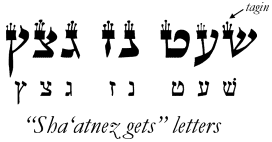|
- Mysteries of Gimmel
In the Talmud it is said that the Gimmel symbolizes a rich man running after a poor man (the next letter Dalet) to give him tzedakah (charity).  (dalut) in Hebrew means impoverished. Gimmel thus represents the free choice to run after the teaching of Torah by practicing acts of chesed (lovingkindness). (dalut) in Hebrew means impoverished. Gimmel thus represents the free choice to run after the teaching of Torah by practicing acts of chesed (lovingkindness).
The root  (gamal) means to deal out to, to give, or wean. The word (gamal) means to deal out to, to give, or wean. The word  (g'mul) means either recompense or benefit, indicating that the nature of the giving can lead to either blessing or judgment for the one who gives. In other words, how one chooses to "run" the race in Olam Hazeh will determine the outcome of his or her life in Olam Habah. Hence gemilut chasidim is the practice of kindness toward others. (g'mul) means either recompense or benefit, indicating that the nature of the giving can lead to either blessing or judgment for the one who gives. In other words, how one chooses to "run" the race in Olam Hazeh will determine the outcome of his or her life in Olam Habah. Hence gemilut chasidim is the practice of kindness toward others.
The parts of gimmel add up to 16, the same value for  , the verb to be, thus indicating that our giving affects the nature of our existence in the realm of the spirit. , the verb to be, thus indicating that our giving affects the nature of our existence in the realm of the spirit.
The number three also represents stability, like three legs of a stool. From the Mishnah (oral Torah) it is said that the world itself stands on three things: Torah, avodah (worship) and acts of lovingkindness. Other important "triads" include the three patriarchs (Abraham, Isaac and Jacob) and the sections of the Tanakh (Torah, Nevi'im, and Ketuvim).
- Gimmel in the Tanakh
The  (go'el) is the name for the kinsmen Redeemer (Lev. 25:26; Num. 5:8; 35:19, 21-7; Deut. 19:6, 12; Jos. 20:5, 9; Ruth 3:9, 12; 4:14; 2 Sam. 14:11; Isa. 49:7). (go'el) is the name for the kinsmen Redeemer (Lev. 25:26; Num. 5:8; 35:19, 21-7; Deut. 19:6, 12; Jos. 20:5, 9; Ruth 3:9, 12; 4:14; 2 Sam. 14:11; Isa. 49:7).
YHVH Himself is identified as the ultimate Redeemer of Israel and mankind (Psalm 19:14[5-H]]). God is also revealed as  (gadol) and (gadol) and  (gibbor), the great and mighty One who brings about true (gibbor), the great and mighty One who brings about true  (ge'ulah) or redemption. (ge'ulah) or redemption.
- Gimmel is a Picture of Yeshua as our Redeemer
Yeshua the Mashiach is identified as the Redeemer of mankind (John 4:42). He is the One who, being born into the world, runs forth bearing charity for the poor ones who stand "behind the door." He is our nourishment and our great Benefit. But for those who spurn His love, Yeshua represents judgment and recompense (i.e., the Avenger of blood, called go'el haddam).
Note that Gimmel also can mean "lift up," as a camel lifts up the one who is upon it. Likewise, Yeshua has been lifted up and exalted before the world as the One who has conquered sin and death on our behalf. Benefit indeed!
- Gimmel is a Picture of the Holy Spirit
Aleph (1) and Bet (2) equal Gimmel (3), suggesting that Gimmel (3) represents the Holy Spirit proceeding forth from the Father (Aleph) and the Son (Bet). And what is the role of the Holy Spirit (or Helper) in olam hazeh? It is threefold: to convict of sin, righteousness, and judgment to come (John 16:8). And He will "take what is mine and declare it unto you" (John 16:14), bringing true aide to the poor who are trapped behind the door.
- Gimmel is a picture of Grace
According to Soferut, Gimmel is formed from a Zayin and a Yod. Zayin means "sword" and Yod means "hand." Here then is a picture of grace: Gimmel approaches the poor man of Dalet, behind the door, with an open hand (the "sword" (of Zayin) is facing the other direction). The Holy Spirit comes, as the Emissary of Jesus, and knocks on the door of the heart. The sword of judgment, however, is sheathed, and this then represents the opportunity to repent and let the Spirit of God into your heart.
May you soften your heart today and know the outstretched hand of God -- and not the edge of the sword of His judgment.
- Crowned Letters
In some Torah Scrolls, eight Hebrew letters are given special adornment by attaching three "tagin" or crownlets to them. Collectively these letters are sometimes called "sha'atnezgets" letters (for Shin, Ayin, Tet, Nun, Zayin, Gimmel, and Tsade).
Midrash ascribes the origin of the tagin as part of mattan Torah - the giving of the Torah at Sinai. The Talmud describes Moses wondering about why God was affixing these embellishments to certain letters of the Torah:
"When Moses went up to God, he found God sitting and putting little crowns on the top of the letters of the Law. He said to God, 'Who is it that forces You to put crowns to the letters of the Law [which You have already written]? He replied, 'A man is to appear on earth after many generations, Akiba b. Joseph by name, who will expound for each top of every letter of the Law heaps and heaps of rulings'...." Talmud (Menachot 29b)

Some people have wondered if these crownlets are the "tittles" referred to by Jesus in Matthew 5:18, although it is unclear that the tagin were in use at that time. It is more likely that the "tittle" refers to the "kots" or "thorn" that projects from a letter.
|








